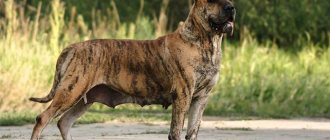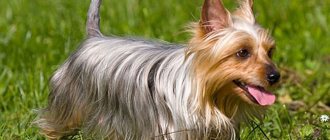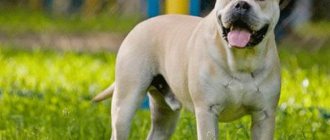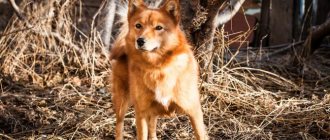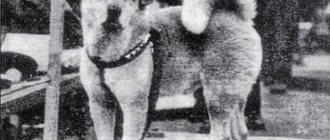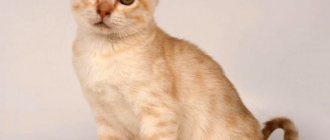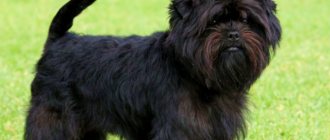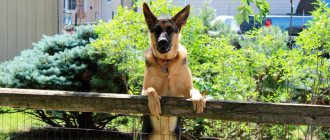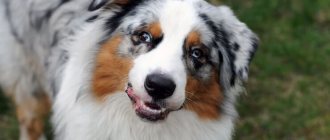Breed characteristics
| Short description | |
| Origin: | Australia |
| Conditions of detention: | In a private house in the countryside, with a large garden |
| Purpose: | Companion dog, herding dog, rescue dog, caregiver dog |
| Color: | Dark gray with blue combined with red, blue with black, red with white. Most dogs have a white patch on their forehead called a "Bentley" |
| Wool length: | Average |
| Adult dog size: | The height of females is 43 – 48 cm, males 46 – 51 cm, weight of males 16 – 23 kg, females 12 – 18 kg. |
| Average life expectancy: | 12 – 16 years old. There have been cases where a dog lived to be 29 years old. |
| Walk: | Daily, more than 3 hours |
| Physical activity needs: | High demands for physical and mental activity (daily training for more than 3 - 4 hours a day). |
| Fédération Cynologique Internationale (FIC) classification: | Breed outside the FCI classification, recognized by AKC, CKC, KC(UK), UKC, ANKC, NZKC |
| Puppy price: | From 10,000 to 50,000 rubles |
Appearance
The Austrian Heeler is a robust, proportionally built, compact dog that should give the impression of agility, strength and tenacity. Should not be overweight or lazy. The body is somewhat elongated, the length to height is 10 to 9. Height at the withers for males is 46-51 cm, for females 43-48 cm, average weight is 20 kg.
The head is proportional. The skull is wide, slightly convex between the ears. The stop is clearly expressed. The muzzle is wide, of medium length, deep, gradually tapering towards the black nose. The lines of the muzzle and forehead are parallel. Lips are dry and tight. The cheekbones are muscular and not protruding. The jaws are strong, the lower one is especially well developed. The teeth are healthy, strong, scissor bite. The eyes are medium size, oval, dark brown in color. The ears are medium in size, wide at the base, erect, with moderately pointed tips, set wide apart and turned to the sides. The inside of the ear is covered with fur.
The neck is very strong, of medium length. The topline is level. The back is strong and strong. The loin is wide. The croup is long and sloping. The chest is muscular, deep, moderately wide. The ribs are rounded, but do not make the chest barrel-shaped. The sides are deep. The tail is set very low, reaches the hock joint, and is drooped or slightly curved. The tail ends with a tassel. The forelegs, when viewed from the front, are straight and parallel, very strong. The hindquarters, when viewed from behind, are straight and parallel, wide, muscular and strong. The paws are round, the toes are short, well knit. The claws are short and the pads are hard.
The coat is smooth, double, formed by a short, thick undercoat and straight, hard outer hair, which fits tightly over the body and protects the dog well from moisture. On the hips the fur forms small fringes. On the head and front of the limbs it is very short. The average body hair length is 2-4 cm.
Possible colors:
- Blue with specks, with or without other markings. Black, blue, and fawn markings on the head are allowed. Spots on the body are undesirable. The front legs are covered with scorch marks, and they are also present on the jaws and inner thighs.
- Red or tan with uniform red markings throughout the body, including the undercoat. Markings on the head are desirable; markings on the body are acceptable, but undesirable.
History of the origin of the species
The development of the Australian Heeler breed was of a practical nature. After settlers and former prisoners of hard labor from England began to develop Australian lands - the state of New South Wales. The British turned the uncultivated Australian lands into cattle breeding. Shepherds needed a helper dog, so they began to import breeds from the shores of Foggy Albion to the continent. The hot climate was difficult for the dogs to tolerate, which affected their performance and vitality.
Attempts by breeders to cross various breeds with the Australian dingo dog were unsuccessful. Farmers were not satisfied with dogs with high aggression and low endurance.
The perfect combination of dingo and collie resulted in the Australian Cattle Dog breed. Later, to increase positive qualities, farmers crossed the heeler with the following breeds: Dalmatian and Australian Kelpie.
The Australian Heeler is a working dog, adapted to life in the humid subtropics, and is very popular on the distant continent.
The breed was officially recognized by dog breeders around the world and registered with the dog handlers association in 1972.
In America, healers appeared after the Second World War, in Europe in the 80s of the last century. Russian breeders began to be interested in the breed only in the early 2000s.
Health and Diseases of the Australian Heeler
The ancestor of the dingo and collie is distinguished by excellent health. But, like any organism, the breed has a predisposition to genetic diseases:
- Deafness. In puppies it is determined at the age of six months. According to statistics, 14% of kitties are deaf in one ear and only 2% are deaf in both.
- Blindness. Characterized by retinal atrophy.
- Hip dysplasia. To prevent the development of the disease, experts recommend avoiding strenuous physical activity (including running) until the puppy reaches 12 months.
- Oncology.
Lifespan
Life expectancy is 11–12 years with proper care of the pet (diet, regular visits to the veterinarian).
Interesting fact! An Australian heeler named Bluey lived to be 29 years old in the early 20th century.
Distinctive features
The main parameters characterizing the Australian Cattle Dog:
- The head is similar to its progenitor - the dingo. The muzzle is not long, but wide.
- Ears do not have a specific standard. There are large, medium and small. They do not adjoin each other, they are always level and in a standing position.
- The tail is short and thick, used when running for better aerodynamics.
- The eyes are neat, not large, and have a brown color. The look contains the mischief of a wild dog, passed down from its ancestors.
- The body structure is not bulky, athleticism is present due to its playful character and mobility.
- The wool is double-layered for good body thermoregulation.
- The lips and nose, as a distinctive feature of the breed, are black.
- bite - originally used to bite livestock on the lower limbs.
Education and training
The Australian Cattle Dog, despite its temperament and instincts, is easy to train and train. The dog really wants to please its owner all the time. And if you want to go through an obedience or general training course with her, the Australian Heeler will do it completely willingly. Therefore, by properly organizing classes and distributing the load, you will get a calm and balanced dog. But don’t forget strength of character and perseverance; at first it’s not easy to raise a dog mixed with the blood of wild Australian dingoes.
It is not advisable to take on a working dog as your first dog, and especially an Australian Cattle Dog, if you cannot channel its energy and instincts in the right direction, there could be big problems. For example: the reflex to bite cows on the heel is so strong that sometimes Australian heelers (in the absence of proper education or dominant behavior) transfer this habit to people.
However, no matter how badly the heeler puppy behaves, the main principle of raising these dogs is the impossibility of using violence. The breed was originally bred to work independently; your pet is capable of making independent decisions, so it will never do what it considers wrong or unnecessary. The education and training of these Australian “free shepherds” must necessarily be based only on encouragement and moral reprimand.
Photo of an adult Australian Heeler dog
Features of character and behavior
The Australian Cattle Dog is a breed that has endless energy. The activity in action is simply incredible. It is not surprising that for the shepherds on the Australian continent, there was no better friend and helper. The ability to independently monitor the herd and make instant decisions has been recommended as the best working breed.
Advantages
The advantages of the Australian Heeler include:
- Intelligence – the breed is positioned as one of the smartest and is included in the top 10 in the world.
- Pets are very affectionate and gentle towards their owner. They try in every possible way to please, to do everything right, in order to receive praise in return.
- They respond well to training. Thanks to their innate organizational abilities and mental development, dogs achieve good results, which are assessed with the highest scores at competitions and exhibitions.
- They love children . The main criterion of Australian breeders when breeding the breed is based on the fact that the heeler must get along and treat children with care. If contact is not established, mating is prohibited.
- Curiosity and sense of humor. The dog will be delighted if he sees something that can make his owner laugh or please. Curiosity manifests itself constantly, this is facilitated by innate mobility.
- Dimensions and health. The object does not belong to the category of large dogs, transportation will not cause inconvenience. The breed is famous for its strength and excellent health.
- There are no whims with food. A working dog, he will eat what he gives.
Flaws
There are only a few disadvantages:
- Heeler sees an authoritative leader in only one person. He treats other family members with respect, but does not allow complete submission. A new personality for a dog is an object for research and adaptation.
- Beginning breeders should not adopt this breed. Only experienced, avid dog breeders will be able to cope with the wayward, moderately wild character of the pet.
- The Australian Heeler will not live long without a purpose ; with dull, passive activity, he will simply wither away.
- The owner must completely get rid of the idea of putting the pet on a chain; this type of restriction is unacceptable for the breed .
Character
The Australian Heeler is not a toy dog. Therefore, she is valued not so much for her beauty and external compliance with standards, but for her character and working qualities. Although the breed standard also says a lot about this. So, what is the character of the ideal Australian Heeler?
The main qualities are deep loyalty and devotion to the owner, as well as obedience. In addition, the herding dog has a pronounced protective instinct. She should be distrustful of strangers or animals.
Other mandatory qualities are courage and high intelligence, this is inherent from birth. At home, Australian Kettles are engaged in driving cattle over long distances. Sometimes the owner is not around, and then the dog must make decisions himself and be responsible for the safety of the herd. Therefore, the breed, according to animal psychologists, is one of the ten smartest dogs. And owners of healers note that their pets sometimes show incredible cunning.
Also, healers are real hard workers. They love to work and carry out their duties zealously. If they are not assigned to work, they will become sour and bored. “Unemployed” dogs will find something to do on their own, but not always harmless. So you shouldn’t let the Australian healer’s busy schedule take its course.
Experts of this breed assure that these dogs are very sociable and affectionate. These are the best hugging and smiling dogs. They follow the heels of their loved one, try to catch every word, understand the mood.
Heelers are similar in activity to terriers, but they calm down much faster. By temperament they are closer to sanguine people, so they are easier to manage. But the dog will obey only the leader of the pack, his master.
Heeler has the utmost respect for hierarchy. He must know his place in the family and understand who is in charge in the house. A well-mannered dog will obey an authoritative leader. Other members of the pack: cats, smaller and weaker pets, can be looked after or “built”. Although in general these dogs are friendly and get along well with all household members.
Australian Kettles love children; they will enthusiastically take part in outdoor games. But they will not tolerate excessive pestering and overly intrusive attention. It is better not to leave children under four years of age alone with a dog. You can only get this dog for a teenage child, who will be able to raise him himself.
Australian healers are neutral towards strangers. As long as they do not violate the boundaries of the territory that the dog considers its own. If a potential threat arises, the dog will be alert and will track the object. To relieve tension, you need to switch his attention.
The Australian Heeler is a cheerful dog with a sense of humor. She rejoices and even smiles slyly when she makes people laugh and amuse herself.
But other people’s dogs “turn on heelers,” and males are especially concerned about this. They will definitely start to find out who is cooler here. But they won’t attack right away; first they will examine, sniff, and growl. If the stranger persists and also shows character, a fight may break out. Therefore, it is better to resolve such situations before the conflict begins.
These dogs are not recommended for very busy people who are rarely at home. Australian Kettles have a hard time withstanding loneliness. They are sad and may start acting up, howling or barking. By the way, their voice is unique. Some people think it resembles the hooting of an owl. But not all heelers are “talkative”; there are also silent ones in this breed.
It is not recommended for sedentary people to adopt a puppy of this breed. For health and mood, a healer needs a lot of movement, active games and activities.
Care and maintenance
The Australian Heeler is absolutely not a fan of the urban jungle. The dog was bred to protect the herd, so the modern pet needs physical exercise and walking. Lack of movement will lead to aggression, weight gain and moodiness.
A plot with a large area is an ideal option for a healer. Due to its innate curiosity, the dog tends to run away, so the breeder should strengthen the fences of the area well, keep gates and gates in a closed position.
Nutrition
The diet and diet of the breed does not differ from the accepted rules:
- Balanced meals twice a day should not be in large quantities. Larger portions are needed after increased loads.
- Dogs, as predators, prefer meat products, but for comprehensive development, it is necessary that the diet contains fats, carbohydrates, fiber, and vitamin supplements.
- The dog breeder must monitor the quality and freshness of the food. If the dog eats natural food, create a balanced diet menu for the day, consisting of meat, fish, vegetables and dairy products.
- Particular attention is paid to the drinking regime. The dog is active, the water bowl should always be full.
- The carbohydrate component is required in a minimal amount so as not to increase the load on the liver. Chocolate, sweets, and cookies are prohibited. Pickled, spicy, salted and smoked products are also contraindicated. The animal's enzyme system is not adapted to digest such food.
- Purchase factory-made feed from trusted suppliers, pay attention to the composition, date and place of manufacture. The minimum amount of stabilizers and additives is the key to your pet’s health.
Mother's milk serves as food for newborn puppies. The general diet is introduced from 2 months of age. Complementary feeding begins with curd protein and fermented dairy products. The next step is to introduce meat protein (in the form of minced meat) with vegetables. Puppies are transferred to a standard feeding regimen at six months of age.
Health
The Australian Cattle Dog is an energetic, very active and healthy breed. It easily adapts to living conditions and is famous for its lack of whims.
Genetically transmitted traits are acceptable for any breed. When choosing a pet and planning to breed puppies, it is necessary to carefully study the pedigree and diseases inherent in the breed.
Vaccinations
When purchasing a puppy, the seller provides the buyer with a veterinary passport for the pet. It reflects all vaccinations received. Next, the owner takes upon himself to vaccinate the dog, according to the vaccination schedule.
Before the procedure, the doctor conducts an examination, and the owner is notified of possible consequences (allergic reactions). Early anthelmintic therapy is required. The dosage is selected by an experienced veterinary specialist.
The main stage of mandatory vaccination is carried out during 1 year of the pet’s life and includes vaccinations against:
- Rabies – done at 3 months of age.
- Parovirus enteritis - done at 2 months of age.
- Distemper - done at 2 months of age.
- Leptospirosis - done at 2 months of age.
After the procedure, the pet becomes weak and the temperature may rise. You should refrain from walking for 2 weeks, especially avoid contact with yard dogs. Swimming and sudden changes in diet are prohibited.
The breeder plans revaccination when the puppy turns 1 year old; complex vaccines that produce antibodies to several diseases at once are allowed.
Diseases
The Achilles heel of the breed is:
- Eyes – retinal dysfunction, cataracts, lens luxation (lead to blindness);
- Joints – dysfunction of the hip, elbow, ankle joints (immobilization);
- Ears – deafness.
Worms will cause a lot of trouble for the owner, so you need to have approved anthelmintic drugs in your medicine cabinet.
To diagnose and prevent the disease, your pet should be regularly taken to the veterinarian for examination.
Walk
Owners who prefer indoor gatherings should refrain from purchasing this breed. The Australian Heeler cannot live without active walks, which take more than 3 hours. Running, jumping, and mental exercises will direct the pet’s innate excessive energy in the right direction.
Grooming
Taking care of the appearance will not be a hassle. Pet hygiene consists of periodic brushing and cleaning of the ears. Carry out bath procedures occasionally, as they become dirty.
Average prices
Since this dog breed is quite rare and has not yet spread to Russia, the cost of purebred puppies is high and starts at 40,000 rubles. The price varies depending on the nursery, parents and gender. In any case, you need to purchase a heeler from trusted breeders with a good reputation.
The Australian Cattle Dog will become a devoted friend and companion. These dogs are active, inquisitive, playful and loyal. But before you buy such a dog, you need to carefully weigh everything, since you cannot leave them alone. In general, this breed is ideal for people living in private homes.
Mating
Mating must be taken very seriously in order to get healthy offspring:
- Before the procedure , be examined by a veterinarian and take genetic tests. Unfortunately, if the dog is a carrier and especially a carrier of a disease that will affect the offspring, mating is prohibited. Various crossing options are considered when there is a high probability of the birth of healthy puppies. The breeders are responsible in each case.
- Heeler individuals that have reached 1.5 years of age . Bitches go into heat in the autumn and spring. It is customary for owners to breed a pair on the 2nd or 3rd heat and 8–10 days after the start.
- Mating takes place traditionally in the male dog's territory . If the male does not recognize the female and shows aggression, the procedure is repeated every other day. The best time of day for mating is morning.
- After proper mating and three months of gestation, puppies appear. The quantitative component of the litter is 1 – 7 pieces.
Heeler coat and color
The coat of Australian Heeler dogs is short, shiny and waterproof. Under its main coat there is a thick undercoat. Dog handlers say that dogs' fur is made up of guard hairs.
The color of a heeler can be of two colors: • red; • blue or bright blue (this can be seen in many photos of the animal).
Sometimes the Australian Heeler breed is endowed with a large number of light gray markings. As the description of the breed says, mottledness is rightfully considered a heritage from the dingo. Looking at the photo of the animal, it is possible to notice that the blue heeler is covered with gray or yellowish markings, which are observed on the tips of the fur. This makes the dog even more unusual and interesting.
Key points in training
The dingo's wild nature and activity are not an obstacle to training. The Australian Heeler's desire to please its owner takes precedence over its instincts. Your pet will be happy to follow commands during training courses. Independent organization of training should include loads of various types. Likes to do exercises where you have to think, loves praise very much. The dog will see the owner as a leader who must be obeyed and obeyed.
Training should not be accompanied by violence. The owner calmly presents the established rules. In case of disobedience or mischief, carefully move the puppy away (like the mother) and speak in denial.
The instinct, passed down from descendants - shepherds, to bite the legs, is eliminated by pointing out to the puppy that this cannot be done, but not by shouting or aggressive actions.
With proper organized training, the pet is unlikely to damage the owner's personal belongings. This is facilitated by conversations and explanations of the owner, in whom the healer sees an authoritative person.
Read about how to properly train a dog in the article: “Training a puppy: effective methods from dog handlers, learning commands at home.”
Price of puppies
Australian Heeler puppies cost from 25,000. The average price is 35,000, and the maximum is 70,000. The price depends on the class of the puppies’ parents.
If both have an exhibition rating of “very good”, there is nothing to ask for millions. If the parents are multiple winners of international exhibitions, the high cost of the puppies is justified.
The price of the healer is also affected by the seasonal factor. In the summer, any puppies sell worse. In winter, demand increases. Dogs are sold especially profitably on New Year's Eve. Some people order living gifts. The same goes for the cost of mating.
On the eve of summer, male breeders ask for less and are often ready to accept payment in 1-2 puppies. There are usually 4-6 of them in a litter.
By buying an Australian heeler, you are buying a friend for the next 12-20 years. This is the framework of life for healthy dogs. In rural areas, healers live longer. This, again, is an observation of Australians who revere their native breed and conduct statistical calculations regarding it.
How to choose a puppy
The breed is not very common in Russia and there are several options for purchasing puppies:
- In the nursery. The most reliable option. There is a caveat: to get a purebred Australian Heeler, you will have to wait in line, but the future owner will be confident in genetic purity.
- At exhibitions and by advertisement. It is advisable for a breeder planning a purchase to choose together with an experienced dog breeder, so as not to run into deception.
The criteria for purebredness and genetic purity of this breed include:
- Puppies are always born white with black spots; gradually the color turns to reddish or gray-blue.
- Lips and nose are only black.
- Scissor bite of the jaw. Missing teeth are a sign of a defect.
- Eye color is always shades of brown. Blue eyes in puppies are also recognized as a defect.
Now we know what kind of breed the Australian Cattle Dog is. Due to the high cost and low prevalence in the country, you should not rush to the first option. You should contact experienced breeders directly before purchasing and evaluate the pros and cons of keeping a pet of this breed.
Description of the Australian Heeler breed with photos
The Australian Cattle Dog is a compact, medium-sized dog. She is very strong, has a muscular body and a large head.
Australian Heeler photo
Breed standards.
- Wide skull. There is a slight bulge between the ears. The head is proportional to the body.
- The muzzle is long with a smooth taper towards the nose.
- Powerful jaws with developed cheekbones. Scissor bite.
- The eyes are dark, medium-sized. Eye set is average.
- The ears are wide, pointed, covered with hair.
- 6.Neck – powerful, medium length.
- The body has a rectangular shape. The chest is rounded due to the sloping ribs.
- The tail ends in a pronounced tassel.
- The paws are powerful and strong. The shoulder blades are located towards the shoulder girdle.
| Floor | Maximum height | Weight Limit |
| Male | 50 cm | 23 kg |
| Bitch | 48 cm | 21 kg |
Color and coat type
Colors:
The Australian Cattle Dog has a smooth, medium-length, two-layer coat. The undercoat is thick and hard. When examining the dog from behind, about the hips. The collar area is thicker and the hair is longer.
Color:
- The Red Heeler (red species) has a red or tan-colored coat. The specks are evenly localized. The presence of spots on the body is allowed, but not desirable. The breed is identified by spots on the head.
- The Blue Heeler has a blue coat. Spots are allowed only in the head area.
